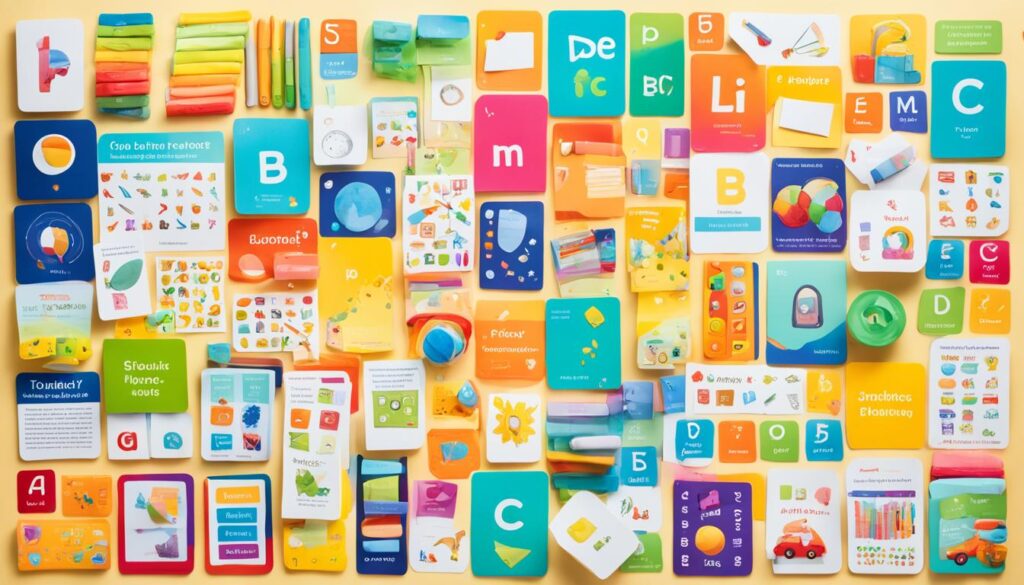Explore the enchanting world of literature! Did you know that early childhood development plays a crucial role in shaping a child’s future? Studies show that children who are introduced to reading at a young age tend to excel academically and have higher self-esteem. This article will examine proven reading techniques that can unlock your child’s educational potential and pave the way for long-lasting reading achievement.
Key Takeaways:
- Early childhood development is essential for setting the stage for academic success.
- Reading strategies can unlock a toddler’s learning potential.
- Building a strong reading foundation at a young age can boost self-esteem and confidence.
- Investing in early reading skills creates a lifelong love for books and learning.
- Implementing proven reading techniques sets the stage for future academic achievements.
The Power of Phonics in Reading Success
Phonics plays a crucial role in laying the foundation for reading success in children. By teaching them the relationship between letters and sounds, phonics helps young learners decode and recognize words effortlessly. It enables children to develop strong literacy skills at an early age, boosting their confidence and fostering a lifelong love for reading.
Strong phonics skills are also linked to improved comprehension, vocabulary, and writing abilities. By investing in phonics education, parents and educators set children up for a bright future filled with reading success.

Phonics provides young learners with the tools they need to unlock the magic of reading.
Through phonics instruction, children learn to associate individual letters or groups of letters with specific sounds. This phonetic knowledge empowers them to sound out words, recognize familiar words quickly, and decode new ones. As children’s phonics skills improve, so does their reading fluency and comprehension.
Moreover, phonics education enhances vocabulary, enabling children to expand their word bank and express themselves more effectively through writing. It lays the groundwork for building strong literacy skills that are essential for academic success across subjects.
Key Benefits of Phonics Education:
- Develops strong reading skills
- Boosts confidence and fosters a love for reading
- Improves comprehension and writing abilities
- Expands vocabulary
By prioritizing phonics instruction, we equip children with the tools they need to become successful readers and lifelong learners.
The Phonics Approach to Teaching Reading
In the realm of reading instruction, the Phonics approach reigns supreme. This tried-and-true method focuses on teaching children the vital link between letters and their corresponding sounds, also known as letter-sound correspondence. By mastering this fundamental skill, children can effectively decode words and unlock the magic of reading.
The Phonics approach starts with teaching children the individual sounds of letters. Through this systematic approach, children gain the ability to recognize familiar words and decipher new ones with ease. As their phonics skills progress, children explore more complex phonetic concepts such as digraphs (two letters representing one sound) and diphthongs (two vowels producing a unique sound).
By understanding the relationship between letters and sounds, children can embark on a journey of reading success. The Phonics approach provides a strong foundation for decoding, which is crucial for reading fluency and comprehension. It equips children with the tools to break down words, allowing them to confidently tackle any text.
“The Phonics approach provides a solid foundation for reading success by teaching children the connection between letters and sounds.”
Embedded within the Phonics approach is a critical skill called decoding. Decoding involves blending individual letter sounds together to form words. This process allows children to smoothly and effortlessly read written text. With continued practice and exposure to various phonetic patterns, children develop a repertoire of decoding strategies, enabling them to tackle words of increasing complexity.
The Phonics approach is at the heart of reading instruction, empowering children to become independent readers. It fosters a love for reading and opens the doors to a world of knowledge and imagination.

| Benefits of the Phonics Approach: | Effective Techniques for Teaching Phonics: |
|---|---|
| 1. Enhances reading fluency | 1. Engage students in interactive phonics games |
| 2. Improves decoding skills | 2. Use picture cues to reinforce letter-sound correspondence |
| 3. Develops strong phonemic awareness | 3. Integrate multisensory activities like tactile letter tracing |
| 4. Boosts reading comprehension | 4. Incorporate phonics instruction into reading aloud sessions |
Engaging Activities for Phonics Learning
Incorporating engaging activities into your child’s daily routine can make mastering phonics skills enjoyable and effective. By making learning fun, you can stimulate your child’s curiosity and motivate them to develop their phonics skills, which are essential for reading development. Here are some engaging activities to enhance your child’s phonics journey:
1. Utilize Educational Games and Apps
Make use of educational games and apps that focus on letter-sound recognition. Platforms like ABCmouse or Starfall provide interactive and entertaining ways to practice phonics skills.
2. Create DIY Flashcards
Design DIY flashcards with pictures and corresponding words to help your child associate sounds and letters with familiar objects. Visual aids can reinforce phonics skills and facilitate learning in a fun and engaging way.
3. Read Aloud and Encourage Participation
Read aloud to your child and encourage them to read along with you. This activity not only exposes your child to different words and sounds but also helps develop their phonemic awareness and reading fluency.
4. Incorporate Songs and Rhymes
Songs and rhymes that emphasize specific sounds and phonemes can be a fantastic way to reinforce phonics skills. Engage your child in singing or reciting fun and catchy tunes that highlight the individual sounds they are learning.
| Engaging Activities | Benefits |
|---|---|
| Utilize educational games and apps | – Interactive and entertaining learning experience – Reinforcement of letter-sound recognition |
| Create DIY flashcards | – Visual aids for association of sounds and letters – Fun and engaging learning process |
| Read aloud and encourage participation | – Phonemic awareness development – Improvement of reading fluency |
| Incorporate songs and rhymes | – Reinforcement of specific sounds and phonemes – Memorable and enjoyable learning experience |
Engaging activities not only foster your child’s love for reading but also strengthen their phonics skills. By incorporating these activities into their daily routine, you can create a joyous and immersive learning environment that supports their reading development.

Phonics Education for Different Learning Styles
Phonics education is adaptable to various learning styles, ensuring that all students can benefit from the magic of reading. By catering to individual preferences, we can create a personalized approach that engages and empowers each child’s unique learning style.
Visual Learners
For visual learners, incorporating colorful images and flashcards is key. These visual aids help children associate letters and sounds effectively, making the learning process both enjoyable and memorable.
Tactile and Kinesthetic Learners
Tactile and kinesthetic learners thrive when provided with hands-on activities. Tracing letters in sand or using letter tiles allows these learners to engage their senses, making letter-sound connections more tangible and intuitive.
Auditory Learners
Auditory learners excel in an environment that emphasizes sounds and verbal communication. Songs, rhymes, and read-aloud sessions serve as effective tools for auditory learners, allowing them to engage with phonics sounds and develop a strong foundation in reading.
By providing a multi-sensory approach to phonics education, parents and educators can ensure that no child is left behind. Recognizing and embracing different learning styles allows us to unlock the magic of reading for each individual, fostering a lifelong love for learning.

| Learning Style | Activities and Strategies |
|---|---|
| Visual Learners | Utilize flashcards and colorful images to associate letters and sounds effectively. |
| Tactile and Kinesthetic Learners | Engage in hands-on activities such as tracing letters in sand or using letter tiles. |
| Auditory Learners | Engage with songs, rhymes, and read-aloud sessions that emphasize phonics sounds. |
Technology in Phonics Mastery
In today’s digital age, technology has revolutionized the way we approach phonics instruction. Interactive apps and educational games provide a contemporary and exciting way for children to engage with phonics concepts while developing their reading skills. These innovative tools create an immersive learning environment that captivates young learners and fosters their motivation to explore the world of letters and sounds.
One of the key advantages of technology in phonics mastery is the availability of interactive applications. These apps offer personalized learning paths, adapting to each child’s progress and providing targeted support. By tailoring the content to their specific needs, children can focus on areas that require further practice and reinforcement, facilitating accelerated learning and skill development.
With technology-integrated phonics instruction, parents and educators can easily monitor and track a child’s progress in real-time. By accessing comprehensive reports and data analytics, we can gain valuable insights into their strengths and areas for improvement. This enables us to adjust our teaching strategies accordingly and provide individualized support, ensuring optimal learning outcomes.

Moreover, technology creates an interactive and collaborative learning environment where children can engage with peers and educators. Whether through virtual classrooms or discussion boards, students can exchange ideas, ask questions, and receive feedback, fostering social interaction and improving their understanding of phonics concepts.
Advantages of Technology in Phonics Mastery:
- Engaging and enjoyable learning experiences
- Personalized learning paths for individual progress
- Real-time progress monitoring and tracking
- Collaborative learning opportunities
By integrating technology into phonics instruction, we harness the power of interactive apps and digital platforms to enhance children’s reading skills and create a strong foundation for their lifelong love of reading. It is an exciting time to explore the endless possibilities that technology brings to the world of phonics education!
Building Fluency for Reading Success
Introducing phonics is just the first step towards unlocking the magic of reading. While phonics helps children recognize and decode words, developing fluency is essential for comprehension and a confident reading experience. Fluency enables children to read accurately, with proper expression, and at an appropriate pace.
To build fluency, engage children in a variety of activities that focus on oral reading, listening to stories, and practicing sight words. These activities help children develop reading rhythm, fluidity, and automaticity. As they become more fluent, their reading comprehension skills improve, and they can dive deeper into the meaning and nuances of a text.
Guided Oral Reading:Encourage children to read aloud with guidance and support. Select age-appropriate texts and take turns reading paragraphs or pages. Provide feedback and model fluent reading, emphasizing aspects such as intonation, pacing, and expression. This collaborative approach strengthens their reading skills and boosts confidence.
Listening to Stories:Expose children to a wide range of stories through read-aloud sessions or audiobooks. Hearing a fluent reader read with expression and emotion helps them internalize the rhythm and cadence of well-written prose. It also exposes them to different genres, styles, and vocabulary, enriching their reading experience and comprehension skills.
Practicing Sight Words:Sight words are high-frequency words that appear regularly in text. Practicing sight words improves reading speed and accuracy, contributing to fluency. Create flashcards or use online resources to help children recognize and memorize sight words. Incorporate games and fun activities to make sight word practice engaging and enjoyable.
Remember, building fluency takes time and practice. Provide ample opportunities for children to read aloud, listen to stories, and practice sight words regularly. Positive reinforcement and praise are essential in boosting their confidence and motivation. By focusing on fluency, parents and educators can help children strengthen their comprehension skills, enjoy a more immersive reading experience, and truly unlock the magic of reading.
“Fluency is the bridge between decoding and comprehension. It allows readers to fully immerse themselves in a text and extract meaning effortlessly.”
—Dr. Sally E. Shaywitz
Strategies for Developing Reading Fluency
| Activity | Description |
|---|---|
| Guided Oral Reading | Take turns reading aloud with guidance and support, focusing on intonation, pacing, and expression. |
| Listening to Stories | Expose children to a wide range of stories through read-aloud sessions or audiobooks, emphasizing fluent reading. |
| Practicing Sight Words | Engage in activities to recognize and memorize high-frequency sight words, improving reading speed and accuracy. |

By implementing these strategies, parents and educators can foster fluency development, enhancing children’s reading skills, comprehension, and overall reading experience.
The Benefits of Early Phonics Mastery
Early mastery of phonics provides a strong foundation for academic and personal growth. Proficient phonics skills enable children to decode words and develop fluent reading abilities. This fluency allows them to focus on understanding and interpreting texts, improving comprehension and critical thinking skills.
Reading proficiency fosters a love for literature and knowledge, nurturing imagination, empathy, and creativity. Early phonics mastery sets children on a path to becoming well-rounded individuals.
| Achievements of Early Phonics Mastery | |
|---|---|
| Improved academic success | Enhanced personal growth |
| Fluent reading abilities | Strong comprehension skills |
| In-depth understanding of texts | Enhanced critical thinking |
| Cultivated love for literature | Nurtured imagination, empathy, and creativity |
Early phonics mastery not only equips children with the essential skills to decode words but also empowers them to excel academically and experience personal growth. It lays the groundwork for a lifelong journey filled with the joy of reading and the endless possibilities it brings.

Overcoming Common Challenges in Phonics Instruction
Teaching phonics to young learners can present common challenges, including different learning paces and maintaining children’s interest. However, with the right strategies and approaches, these challenges can be addressed effectively, ensuring successful phonics instruction.
One of the key solutions is individualized instruction. Recognizing that each child has unique needs and preferences, tailor your teaching techniques to cater to their learning styles. Provide personalized support and attention, and adapt your lessons accordingly to accommodate different paces of learning.
To keep learners engaged and motivated, incorporate interactive and engaging activities into your phonics instruction. Use educational games, hands-on exercises, and multimedia resources to make learning fun and exciting. By bringing variety and creativity into your lessons, you can capture children’s interest and enhance their phonics skills.
Repetition and practice are vital for solidifying phonics rules and concepts. Provide ample opportunities for children to practice their phonics skills through reading exercises, word games, and phonics drills. Regular practice will help reinforce their understanding of letter-sound relationships, improving their reading abilities over time.
A strong home-school connection is crucial in supporting phonics instruction. Collaborate with parents and caregivers to create a consistent and supportive learning environment both in and outside of the classroom. Communicate regularly, share progress updates and recommendations, and provide resources for reinforcement at home. By working together, you can ensure that children receive consistent phonics instruction and support, leading to better learning outcomes.

By overcoming these common challenges and implementing individualized instruction techniques, incorporating engaging activities, fostering ample practice opportunities, and establishing a strong home-school connection, phonics instruction can become an enriching and effective learning experience for young learners.
Conclusion
To instill a lifelong love for reading in your child, we must celebrate their milestones and achievements. By creating a warm reading environment through cozy reading nooks and regular library visits, we can cultivate a passion for books. Offering a diverse range of reading materials that cater to their interests further encourages their engagement with literature.
Collaborating with teachers ensures continuity in reading instruction, allowing for a cohesive learning experience. Additionally, targeted interventions and support help overcome challenges that may arise along the journey. By tracking your child’s progress and celebrating their growth, you can provide the motivation they need to keep advancing.
By implementing these strategies, we unlock the magic of reading and set our children on a path to a successful reading journey. Let’s foster a lifelong love for reading, creating opportunities for personal growth and a richer understanding of the world around us.
How Can Learning Sight Words Help Toddlers Succeed in Reading?
Learning sight words is crucial for toddlers to succeed in reading. By helping toddlers master toddler sight words, they can recognize these common words easily, which boosts their confidence and fluency in reading. This foundational skill sets them up for future success in literacy and academic achievement.
FAQ
What is phonics?
Phonics is a method of teaching children the relationship between letters and sounds, helping them decode and recognize words more easily.
Why is phonics important for reading success?
Phonics lays the foundation for strong reading skills by enabling children to develop fluency and confidence in decoding words.
How can I incorporate phonics into my child’s daily routine?
You can incorporate phonics into your child’s routine by using educational games or apps, creating DIY flashcards, and reading aloud to them.
How do different learning styles impact phonics education?
Visual learners benefit from visual aids like flashcards, tactile learners engage through hands-on activities, and auditory learners thrive with songs and rhymes.
How can technology enhance phonics mastery?
Interactive applications and educational games provide personalized learning paths and real-time progress tracking, making phonics learning engaging and effective.
How can I improve my child’s reading fluency?
You can improve reading fluency by engaging children in activities like guided oral reading, listening to stories, and practicing sight words.
What are the benefits of early phonics mastery?
Early phonics mastery lays the foundation for academic and personal growth, improving comprehension, critical thinking skills, and fostering a love for reading.
What challenges may arise in phonics instruction?
Common challenges may include different learning paces and maintaining children’s interest. Individualizing instruction and incorporating engaging activities can help overcome these challenges.
How can I foster a lifelong love for reading in my child?
You can foster a lifelong love for reading by creating a warm reading environment, offering diverse reading materials, collaborating with teachers, and celebrating your child’s milestones and achievements.









